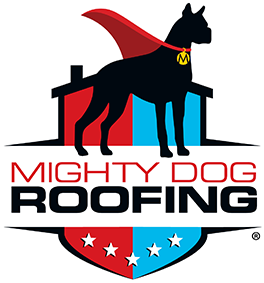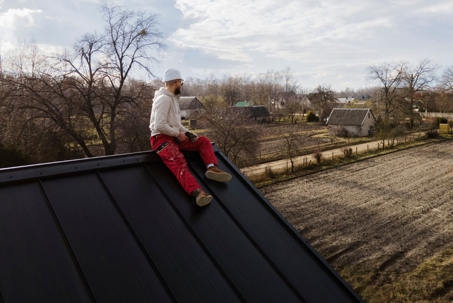What Temperature Is Too Cold to Put on a Roof?
Is it too chilly outside to start roofing your house? Pinpointing the right temperature is key to ensuring your new roof is installed correctly and built to last. Many homeowners wonder about the ideal conditions for roofing, especially when the thermometer dips below 30℉.
Such cold temperatures introduce unique challenges, affecting the materials, the safety of the work crew, and, ultimately, the integrity of your roof. Dive into the essentials of cold-weather roofing with us, as we unveil the critical temperature thresholds, strategic planning for winter projects, and insider tips to navigate the frosty obstacles for a successful roofing endeavor, no matter the weather.
When Is It Too Cold to Roof?
Homeowners in cold climates know the perfect time to install new roofs is in late spring and early fall. Warm weather, clear skies, and sunlight produce the best temperatures to roof a house. However, roof emergencies can occur at any time. Even if the signs of winter have yet to appear, experts consider roofing in cold weather below 30℉ a hazard for personnel, equipment, and roofing materials.
Is it OK to install a roof in cold weather?
It is OK to install a roof in cold weather if the temperatures remain above the suggestions shown on roofing product labels. Although roofing contractors can sometimes discourage roofing projects in the winter weather, they can still perform at a high level if the temperatures are not too cold. Winter roofing requires a lot of careful planning and execution for it all to go well.
Workers must consider the safety hazards and work slower because the surfaces become more fragile due to colder temperatures. Roofers should work with cold-weather adhesives instead of thermal sealants. Wood shingles, metal roofs, and slate tiles serve as better alternatives to winter roofing with asphalt shingles.
What is the minimum temperature to install shingles?
The minimum temperature to install shingles is 40℉. Freezing temperatures prevent roofing materials and adhesive properties from working correctly. Shingles lose their elasticity, and cutting or driving nails through them becomes challenging. That’s why most licensed practitioners recommend 40℉ as the cutoff to install asphalt shingles.
Experts consider dry, warm weather the most opportune time to install a new roof. The best time to install a roof occurs when the temperatures average between 70℉ and 80℉.
How Do Cold Temperatures Affect Roofing?
Roofing in cold temperatures creates a few problems that would otherwise not arise at other times of the year. Roofers need to consider working in freezing weather, which can slow the work and affect the quality of the finished product.
Some roofing products do not work well in the cold weather. Brittle asphalt shingles, adhesive failure, and compromised EPDM top the list of problems that installers face during a winter roofing project. Watch out for these common issues that many homeowners overlook.
1. Brittle Asphalt Shingles
Temperate weather conditions offer the best time to install asphalt shingles. Under these conditions, asphalt shingles retain flexibility and create a waterproof seal. If the temperature drops, asphalt shingles tend to become brittle.
Installing asphalt shingles in winter can create many problems because the stiff shingles break while cutting or hammering nails into them. Cracked shingles allow water to seep through, damaging the house if left unchecked.
2. Adhesive Failure
Installing shingles on a roof involves installing two layers. Roof fitters use nails to fit the base layer onto the roof deck. The top layer of roofing shingles adheres to the base layer with the help of a sealant that cures under the sun’s heat.
If the top layer receives insufficient sunlight, the sealant fails to form a solid bond with the base layer. Strong winds and heavy rain can dislodge the exterior layer and render the roof vulnerable to the elements. Moisture retention can also cause rot and mildew.
3. More Labor Hours
Roof installation in winter requires workers to take extra safety precautions. Additional gear and equipment slows down the project. Roof installers devote more time and attention to preventing mistakes and protecting the roof construction project while it remains in progress.
Roofing in cold weather demands more labor because workers must clear snow or ice dams from the work surface. A roofing contractor must also ensure proper attic ventilation to prevent moisture retention and other damage.
4. Compromised EPDM
Synthetic rubber, or ethylene propylene diene terpolymer (EPDM), insulates a house. The rubber membrane roofing product creates energy-efficient homes. EPDM displays more sensitivity to sub-zero temperatures than asphalt shingles.
For best results, manufacturers suggest temperatures of 45°F during installation. The EPDM adhesive does not work well when temperatures drop below that mark. This failure compromises the home’s insulation and heat regulation.
5. Increased Danger
Roofing in cold weather increases the chances of mishaps and injuries. Workers need to watch their steps and look out for damaged areas of the roof, including loose shingles. High winds and slippery slopes slow down the work, reducing productivity.
Unmarked skylights and icy roofs pose a danger to roof installers, who must take extra precautions to protect themselves. Workers must also watch where they are going on the ground because icicles, snow, and debris can fall on their heads.
Cold-Weather Roofing Tips
No matter how much homeowners prepare for harsh weather, sudden emergencies will compel a professional to get on the roof. For example, a tree branch may fall on the roof, or a poorly fastened shingle may cause leaks in the house.
Although roofing a house in winter requires more work and preparation, a high-quality installation can still bring long-lasting results. Roofers must take extra precautions and use the right tools for a smooth roofing installation.
1. Remove Hazards Like Snow and Debris
Professionals remove snow and other obstacles from the roof before starting work. This step requires a lot of time for a cold-weather project. Snow adds extra weight, which can damage a roof or even cause it to collapse.
The pros protect workers on the ground from falling snow and icicles. They also remove icicles hanging from the roof’s gutters so no one gets injured and replace damaged roof parts caused by overhanging icicles and ice dams.
2. Install Skylight Screens
Stepping on a skylight buried under the snow will cause injuries for roof installers and damage to the roof. Workers can unexpectedly step through a skylight because they can not see it due to the snow cover.
Skylight screens help workers mark a safe path on the roof. Sometimes, unforeseen roofing emergencies that require a quick inspection can occur. Professionals may not have enough time to clear the snow, so a screen around the skylight will prevent accidents.
3. Use Hot Boxes
Roof products tend to lose their efficacy due to extreme weather conditions when installing roofing in winter. Frozen roofing products can result in faulty roof installation. Hot boxes offer a convenient solution for cold-weather storage, transportation, and job-site heating.
Hot boxes protect temperature-sensitive materials, like roof shingles, paint, and roofing cement. Setting up hot boxes requires little supervision and open from both sides, allowing workers easy access to materials.
4. Set Up Guardrails
Working on the roof involves a certain amount of risk as roofers spend most of their time working from an elevated height. Steep slopes and icy tops pose a threat to workers who can fall off and hurt themselves. Guardrails provide added protection for roof installers. Professionals can set up permanent or temporary barriers to prevent falls and other accidents.
5. Invest in Safety Equipment
Experienced roofers keep their workers safe by investing in safety equipment. Safety harnesses, deadweight anchors, roof brackets, and lanyards protect roofers from falling off the edge. Roofing pros demarcate precarious areas on the roof with warning lines so workers can avoid hazards.
Setting up safety equipment at the work site takes a little effort and time. However, those extra precautions will prevent accidents and hospital visits. The roofing team will test the gear and ensure all equipment works before getting on the roof.
Mighty Dog Roofing | Your Cold-Weather Roofing Company
Roofing in cold weather comes with extra risks. However, an experienced roofing contractor can complete a winter project without a hitch. Our expert cold-weather roofers take every precaution when starting a winter roof installation.
Call Mighty Dog Roofing at (833) MIGHTY 4 to schedule a free consultation today. Or you can contact us online.


